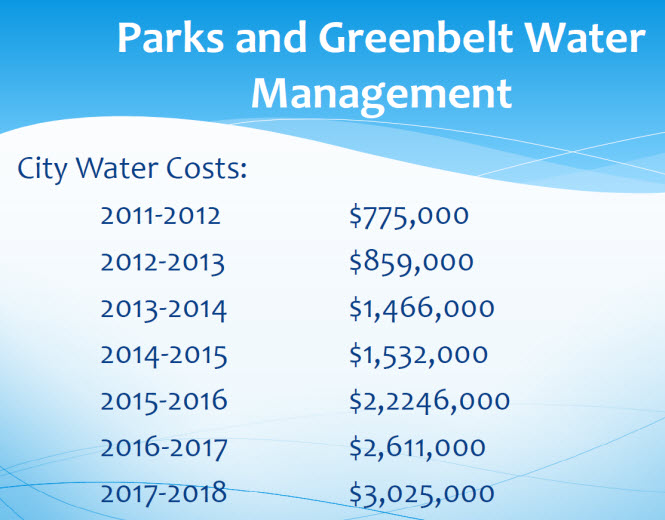
This week we saw the full wrath of the budget come back up to bite us once again. In the city manager’s presentation, we see that the city has opened up another two million structural deficit.
But that is nothing. Over the next five fiscal years, while revenue is expected to increase from just under 42 million dollars to just over 46 million, expenditures go up far faster, exploding from just under 44 million to 52 million.

So by 2018-19, we are looking at a $6 million deficit. As the city manager noted on Tuesday, the city has managed finally to get on top of labor costs – although two bargaining units are holding out at this point. While CalPERS (California Public Employees’ Retirement System) projects a 50-percent rate increase over the next five years, most of the labor costs have been set through the end of 2015.
The city manager acknowledges, however, that medical inflation could still be a wild card, but for the most part the city has labor issues settled.
The two areas of concern are water rates, which will rise substantially due to the passage of Measure I, and the construction of the surface water project. And as the city manager put it, the PCI (Pavement Condition Index) for city streets is reaching a crisis level.
While we have discussed the road maintenance component of this quite a bit, and I still believe the city manager is underestimating the yearly impact of those costs, we have not addressed the water issue.

As you can see from the chart, the costs of water for the city go from around $800,000 to more than $3 million – and a large chunk of that is to water the greenbelts.
In his lawsuit against the city of Davis, Michael Harrington notes that the city of Davis was not billing itself for water use, arguing “the City of Davis knowingly helps itself to the value of 100% of the water used, which effectively illegally subsidizes the City’s General Fund and other departments within the City, to the detriment of the City’s ratepayers, including Plaintiffs.”
To substantiate this claim, Mr. Harrington notes the 2010 city of Sacramento decision.
Tim Bittle, Director of Legal Affairs for the Howard Jarvis Taxpayers Association, noted “a finding by the Sacramento County Grand Jury that after investigation of the City using but not fully paying for its water use, the Grand Jury concluded that the City was” … “overcharging private customers to subsidize its own free use of utility services. The Grand Jury found that the City was acting illegally.”
Like most municipalities prior to 2010, the city did not bill the general fund for water use and the Sacramento case indicated that they should have.
The city has maintained that the bills largely cancel out – or at least did in the past. The increased water rates amplify this concern.
For example, for the 2013-14 fiscal year, the city budgets its water use at $1.46 million with an additional $13,774 going to sewer. This bill is partially offset, the city claims, by utility land lease revenue projected at $800,000.
Still, the claims of the lawsuit, while technically accurate in terms of the law, are odd – the charge that the city is subsidizing the general fund through the water rate payers.
This leaves the city in the situation where they will now have to find themselves about $3 million in general fund revenues to pay the enterprise fund. It is odd to say that the ratepayers are subsidizing the taxpayers when, in fact, for the most part they are one and the same.
It would be an odd occurrence if the city were forced to create another half-cent sales tax in order for the taxpayers to pay their share of the water rate increase.
The notion that the city is being subsidized for its water uses misses a fundamental point – the city is subsidized for every use it has. The city only functions based on tax and other revenues that come from taxpayers and go to the city’s coffers.
In essence, state law makes little sense – the best way to collect money for the city to pay for its water use would be through the same mechanism that they generate their revenue to build the water project to begin with.
Nevertheless, the magnitude of this increase is no small number. The discussion never fully came out during the campaign that the water project would put the city in another $3 million general fund deficit at the same time that they cutting back services and ramping up water rate costs.
The hard numbers were not available for the cost of the city prior to the election. Would it have impacted the outcome of the election?
We have no way of knowing. But suppose, to give a present example, the firefighters caught wind that the water project would lead to an additional $3 million hit on the budget at the same time that they are being asked to take contract concessions and staffing cuts.
Now the firefighters, like all other city groups, stood on the sidelines during the water election, but what if this had become known previously?
The city will, of course, now have to generate this revenue somehow, but that means that they may have to go to a sales tax or parcel tax that otherwise might have been able to go to put more police officers or on the street rather than having citizens forced to create citizen neighborhood watch groups.
It is always best to lay these issues out on the table, because citizens are more likely to give the benefit of the doubt when they do not believe the ball is being hidden.
Before the city asks for more revenue, they need to think about the current costs, the services we need to provide, where we can save money and where we can still cut services, while remaining a strong community.
—David M. Greenwald reporting





